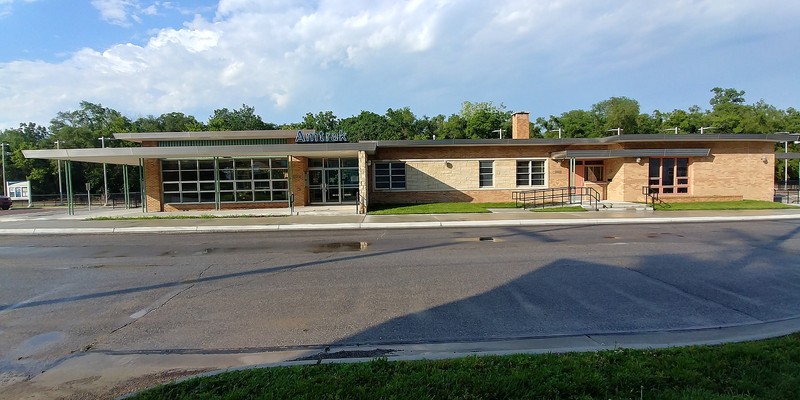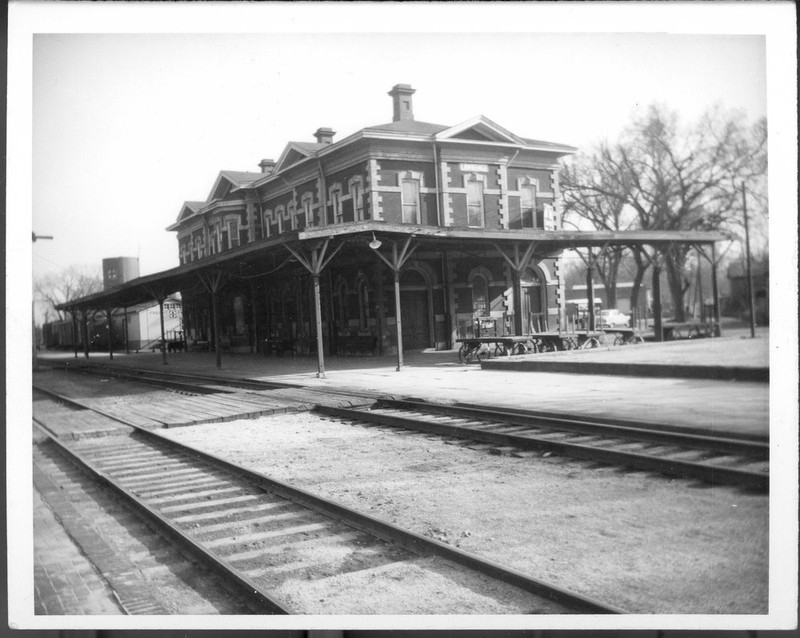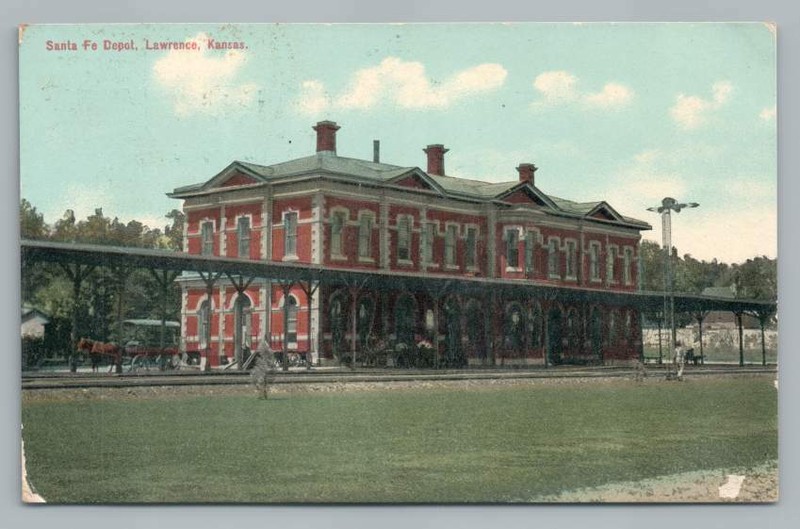Lawrence Station (Santa Fe Depot)
Introduction
Text-to-speech Audio
This historic depot opened in 1956 and replaced a previous depot that had been built on the same lot in 1883. Although Lawrence's early attempts during the mid-nineteenth century to become a major railroad hub faltered as nearby Kansas City became a major terminus, the railroad was essential to Lawrence, with the trains of the Union Pacific and the Santa Fe Railroad both stopping in Lawrence several times per day by the 1880s. Despite the profound popularity of the automobile by the mid-twentieth century, Santa Fe continued to enjoy success in the 1950s, and this building reflects the company's continued investment in Lawrence even as passenger traffic had already peaked at the end of World War II. The midcentury modern building continues to serve passengers as an unstaffed Amtrak station.
Images
Lawrence Amtrack Station (Historic Santa Fe Depot)

Lawrence Santa Fe Depot built in 1883

Lawrence Santa Fe Depot built in 1883

Backstory and Context
Text-to-speech Audio
The nineteenth-century economic model proved quite simple in one regard: in towns where railroads stopped, population, industries, trade, and commerce grew. Businesses and farmers needed access to railroads in order to send and receive goods to other cities throughout the country, and the people in cities relied on trains for access to goods and the ability to travel either locally or to faraway locations. The explosive growth of major cities like Chicago and Atlanta occurred concurrently with increased rail traffic. Still, small towns also needed trains to stop in their communities to grow, or at least survive.
In the 1850s, Lawrence, Topeka, and Kansas City were all about the same size, was about the same size and the town leaders in each town sought deals with railway companies. However, investors and speculators found Kansas City exceptionally appealing, partly because of the geographical advantages (namely the Missouri River). Even by the early 1860s, with the Civil War ongoing, Kansas City had become a regional railway hub, and its population tripled that of Lawrence. Nevertheless, Lawrence continued to strive to attract railways to stop in the town. Indeed, residents voted in favor of more than $900,000 to be spent on railways from the 1860s to 1880s. So, although Lawrence did not become a hub, the Union Pacific and the Santa Fe Railroad Companies served Lawrence several times per day. The railroads stimulated economic growth for Lawrence via rail-related jobs, increased taxable property, and enhanced trade and commerce activity.
Santa Fe Railroad evolved into the town's most prominent railway operator, and the railway company significantly contributed to Kansas's overall population growth during the late nineteenth and early twentieth centuries. The Santa Fe Railroad Company began in 1859 with a charter granted to Cyrus K. Holliday in Topeka, who intended to construct a railway line between Topeka and Atchison, Kansas. Four years later, in 1863, President Abraham Lincoln signed a land grant that provided the Santa Fe Railroad Company with nearly three million acres of land stretching east-west across Kansas to the Colorado border. However, because of the sparse population in western Kansas, the company sold much of its land in the state's western portion. The company instead focused on the state's eastern half, trying to create a "Kansas Road," from areas east of the Mississippi to Kansas via the Santa Fe Railroad. They sent agents to New York and successfully enticed newly arrived immigrants to Kansas. For example, the railway encouraged more than 3,000 immigrants from Russia to settle in central Kansas in 1874. By the early 1910s, the Santa Fe Railroad stood as the largest railroad in Kansas, but its presence in Lawrence started slowly. But, in 1879, Santa Fe purchased the Kansas City, Lawrence, and Southern Kansas Railroad (KCLS), centered in Lawrence. In 1882, Santa Fe announced plans to build a sizable two-story depot in Lawrence housing the head offices of Santa Fe's subsidiary, KCLS.
Santa Fe Railroad built its first Lawrence train depot in 1883 on the same property where the now-historic station stands. Although most late nineteenth-century railroad companies constructed their depots right on the town's main street, the Santa Fe depot arose four blocks east of the city center, in an area known as East Lawrence near all repair shops, storage, and houses for workers. The new two-story depot, a large, elaborately decorated brick building, stood as an elegant addition to the neighborhood comprised of ethnically diverse middle and lower-class houses and businesses.
A significant flood in 1951 (the Kansas River overflowed its banks) damaged the Santa Fe tracks and the 1883-constructed depot in Lawrence. A few years later, in 1955, the Santa Fe Company decided to replace the original depot with a newer station on the same property while demolishing the previous structure.
Although the automobile era had taken a firm hold on American society by the 1950s, the Santa Fe Railroad Company continued to serve numerous passengers. In the post-war era, the Santa Fe Railroad profited from the population and industrial growth boom in the American Southwest, where Santa Fe dominated rail service. The company updated operations and schedules and adopted new switching methods to manage track usage, spending $500 million on new plant and equipment. Santa Fe also benefited from railway innovations, including dome (observation) cars, air-conditioning, and new streamlined trains. Santa Fe also felt justified in building a new depot in Lawrence because of the massive influx of student enrollment at the University of Kansas starting with World War II veterans but continuing on into the 1950s. Santa Fe purchased 160 acres of land to the northwest of the downtown for further industrial development at that time. Of course, the era would prove to be the peak of passenger rail service and the station is now an unstaffed waiting room for passengers on Amtrak's single route in this area connecting Los Angeles with Chicago.
Sources
Bradley, Glenn Danford. The Story of the Santa Fe. Boston: The Gorham Press, 1920. Digitized by the University of Arizona at https://uair.library.arizona.edu/system/files/usain/download/azu_he2791_a83_1920_w.pdf.
Domer, Dennis and Stan Hernly. "Registration Form: Santa Fe Depot." National Register of Historic Places. nps.gov. 2014. https://npgallery.nps.gov/GetAsset/dc6362f0-ff4d-4980-84ee-0fc355b97bab.
Flink, James J.. The Automobile Age. Cambridge, MA: Penguin Random House LLC, 1988.
White, Richard. Railroaded: The Transcontinentals and the Making of Modern America. New York: W. W. Norton, 2011.
By Junedude433 - Own work, CC BY-SA 4.0, https://commons.wikimedia.org/w/index.php?curid=79468367
Kansas Historical Society: https://www.kshs.org/index.php?url=km/items/view/219703
Postcard, various internet sources: https://www.kshs.org/index.php?url=km/items/view/219485
